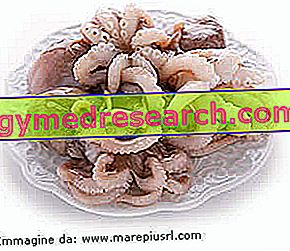Generality
The octopus (or musk octopus) are fishery products similar to the octopus; not by chance they are also called "sand octopus".

Description
From the morphological point of view, the dormice differ from the octopus with regard to: smaller dimensions (on average around 20cm, but they are not rare specimens that reach 70cm), head with a peculiar conformation (oval), more prominent eyes, tentacles provided of a single row of suckers and longer (the third right tentacle of the male specimens is shorter and acts as a reproductive organ).
The baby octopus is gray-brown with black spots; they have a lower mimicry capacity than the octopus and are therefore easier to spot. The largest specimens are found near the Aegean Sea while the greatest population density is located in the northern Adriatic.
Habitat, reproduction and fishing
The dormice is a typical species of the Mediterranean Sea, but is also found in small colonies present in the Gulf of Cadiz, on the west coast of Gibraltar and in front of Portugal (Atlantic Ocean). The dormice live on sandy or mixed bottoms - rocky and muddy; they prefer bathymetrics of about 100m but are present from 15 to 200m of depth. They feed on crustaceans (crabs, spider crabs, shrimp, scampi etc.), fish (sardines, mullets, moles etc.) and other molluscs (bivalves such as mussels, cephalopods such as cuttlefish and squid, gastropods such as sea snails etc. ); they are particularly predated by large pinnutes and some marine mammals.
The dormice reproduce between late autumn and spring, when they pass close to the coast and are captured more easily. The sampling technique consists mainly of trawl, deep post nets and pots.
Gastronomy and nutritional properties
The dormouse can be cooked in different ways; the smaller ones are excellent fried, while the larger specimens represent an elite ingredient for red soups and mixed fish stews. Even the moscardino, like the other molluscs, lends itself considerably to cold sea salads. The accompanying sauces based on baby octopus are excellent for both pasta and polenta.
The octopus is a much cheaper fishery product than the local octopus and is an excellent source of food in the specific fishing period.
From the nutritional point of view, the dormice has characteristics similar to those of the octopus, from which they do not differ significantly; also for this reason, they have not been specifically translated into the food composition tables.
The typical properties of the dormouse are: low energy intake, medium digestibility, high protein quantity (with high biological value) and low lipid concentration. Cholesterol should not be too abundant; carbohydrates are irrelevant and fiber is absent.
From the vitaminic point of view there are no concentrations worthy of note, while with regard to mineral salts excellent concentrations of iron, calcium and potassium should emerge.



